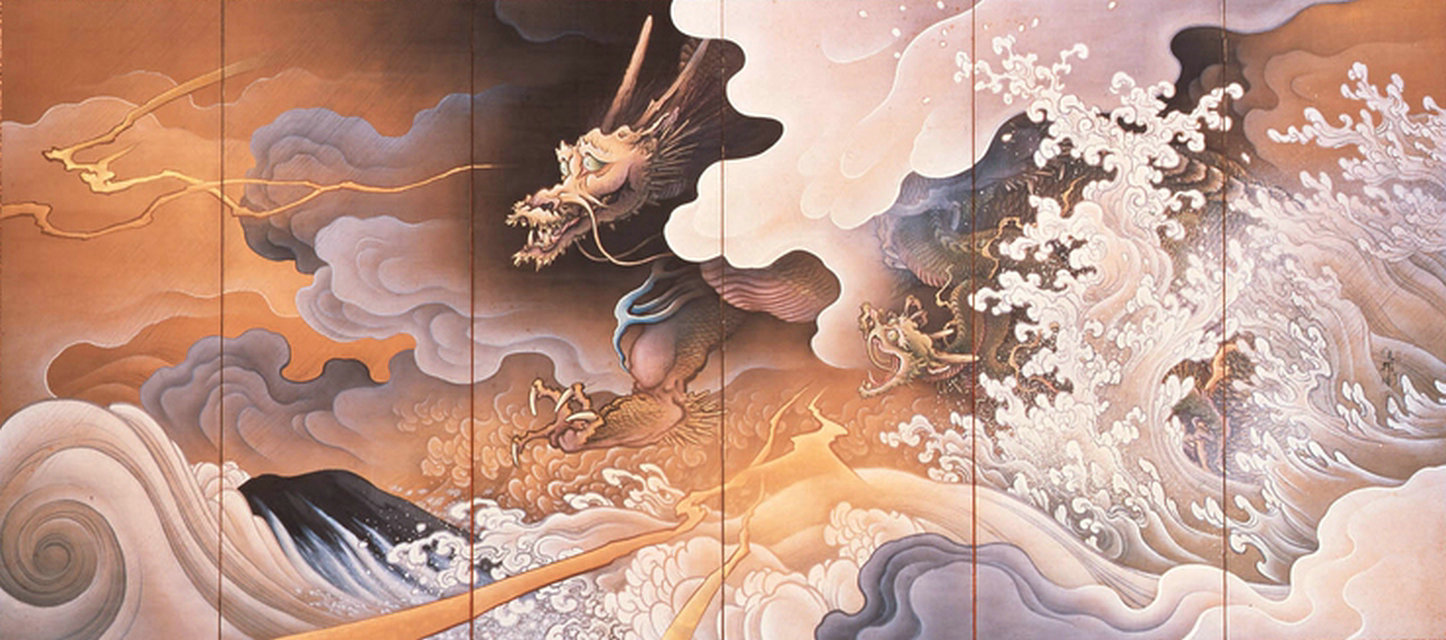Hashimoto Gahō


Hashimoto Gahō (橋本雅邦, Aug 21, 1835 – Jan 13, 1908) was a Japanese painter, one of the last to paint in the style of the Kanō school.
Born in Edo, he studied painting under Kanō Shōsen’in, and was influenced as well by the work of Kanō Hōgai. He created many works in the traditional style of the Kanō school, using color & gold, or otherwise monochrome black ink. But while his paintings are very much the works of a traditionalist, using traditional methods and depicting traditional subjects, Gahō, like Kanō Hōgai, incorporated elements of Western art as well. Brush-strokes, various types of detailing, and in particular, attempts at the proper depiction of perspective are evident in Gahō’s paintings and in many others of this period.
Gahō’s father, Mr. Hashimoto Fishery (Saishama Prefecture), is a painter of the Kawagoe clan, and as the youngest brother of Konoshi-cho Kano family owner Harumi Kanagawa Yoshinobu I had a family in the house of my house. For this reason, YasukunHe was born in the residence of the Kinoh family Kano family in Tenpo six years.
Following customs from the age of 5 received a degree of Kano school from the real father, when officially 12 years old to begin introducing the same as his father. However, because Kozo died this one month later, in fact it can be seen that he succeeded Masanobu Katsukawa in Shin-inon as a successor. At the same time, Kano Kazuki also introduced the same day, and although the young man of mild humanity and the rapture and personality of a passionate person were opposite in seven years old seniority, both were dissatisfied with the current Kano school and expression to original expression Share motivation, become a lifetime best friend. Both of them express their heads as early as possible, becoming a cram school at the age of 23 (1857) 23 years old. Together with Rikao, Kano Katsutama and Kimura Tateaki, he was called the Fourth Royal King of the Katsukawa-in Temple. Particularly called “Hakusuku” was called “Batakuin of Katsukawa-in” and served as the settlement of Genpei together at the cram school’s picture.
He opened his own studio in 1860, but the political and economic upheavals surrounding the Meiji Restoration forced Gahō to seek income in other ways than by selling fine art. He produced maps for the Naval Academy, painted on fans, and used his skills in a number of other ways to earn a living.
The turning point was the rebuilding movement of traditional painting by Ernesto Fenollosa, and he began to explore new expressions techniques along with the ridgeline that was under the protection of Fenollosa. At the 1st Inner Painting Exhibition Committee of Meiji 15 (1882), “Kotegashiki Graphics” (MOA Art Museum Collection) took the lead of the silver stamp and also “Bamboo Dove” (Temple of the Sannomaru Treasury Collection) also exhibited by Miyauchi It is used by the province. In 1884, when Fenollosa launched the Opinion Society, he joined from the early period and began to act vigorously.
Gahō was invited in 1884, by Okakura Kakuzō, to become the chief professor of painting at the Tōkyō Bijutsu Gakkō (東京美術学校, now the Tokyo National University of Fine Arts and Music) which would open five years later.
In the Meiji era (1886) he left the Naval Academy and began to appear at the Ministry of Education’s painting interchange. In this way, under the command of Fenorosa · Okakura Tenshin, preparations are made for the establishment of the Tokyo Art School along with the Risa Cliff, but in 1889 the Ruined Cliff died and the impromptu “Saga Kannon” He was charged with finishing. For this reason, when opening the Tokyo Art School in 1890, he became the chief of the painting department instead of the cliff. In addition, when the Imperial arts and craftsmen system was established in the same year, it was chosen as the first member on October 2, thus climbing to the highest ranking of the painting world at the time as well as the name.
Since then, Yasunaga is regarded as a heavyweight of the paintings although it is in the field, and he is following the activities of the art institute as well as following guidance.
In 1898, Gahō joined Okakura in leaving the Bijutsu Gakkō, and founding the Japan Fine Arts Academy (日本美術院, Nihon Bijutsuin). He would teach there until his death in 1908.
As a result of his position as chief painting professor, Gahō had a number of important pupils, including Yokoyama Taikan and Kawai Gyokudō.
Painting:
Yasukuni is a painter who is in a position to bridge “modern times” and “modern times” of Japanese paintings with both the gate of the same gate, incorporating techniques such as the perspective of Western painting based on the Kano scholarship method along with the Ridge cliff, in the Meiji Era Contributing to the innovation of Japanese paintings in Japan. “Baiyun Kureiki”, one of the masterpieces of Yasukuni, expresses the moonlight and the transparency of the air with delicate colors, based on traditional samurai paintings.
Representative work:
Wikimedia Commons has media related to Hashimoto Masakuni.
“Baiyun Kurei” 1890 / Tokyo University of the Arts University Art Museum (Important Cultural Property)
“Dragon’s figure” 1895 / Shikado Bunko (important cultural property)